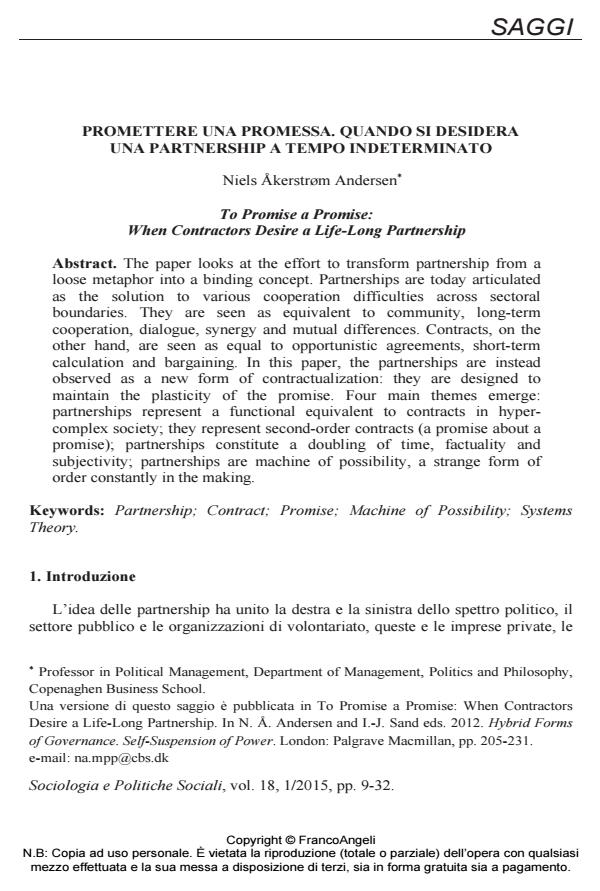To Promise a Promise: When Contractors Desire a Life-Long Partnership
Journal title SOCIOLOGIA E POLITICHE SOCIALI
Author/s Niels Akerstrom Andersen
Publishing Year 2015 Issue 2015/1
Language Italian Pages 24 P. 9-32 File size 137 KB
DOI 10.3280/SP2015-001002
DOI is like a bar code for intellectual property: to have more infomation
click here
Below, you can see the article first page
If you want to buy this article in PDF format, you can do it, following the instructions to buy download credits

FrancoAngeli is member of Publishers International Linking Association, Inc (PILA), a not-for-profit association which run the CrossRef service enabling links to and from online scholarly content.
The paper looks at the effort to transform partnership from a loose metaphor into a binding concept. Partnerships are today articulated as the solution to various cooperation difficulties across sectoral boundaries. They are seen as equivalent to community, long-term cooperation, dialogue, synergy and mutual differences. Contracts, on the other hand, are seen as equal to opportunistic agreements, short-term calculation and bargaining. In this paper, the partnerships are instead observed as a new form of contractualization: they are designed to maintain the plasticity of the promise. Four main themes emerge: partnerships represent a functional equivalent to contracts in hypercomplex society; they represent second-order contracts (a promise about a promise); partnerships constitute a doubling of time, factuality and subjectivity; partnerships are machine of possibility, a strange form of order constantly in the making.
Keywords: Partnership; Contract; Promise; Machine of Possibility; Systems Theory.
- Andersen, N. Å. 2008. Partnerships: Machines of Possibility. Bristol: Policy Press.
- Andersen, N. Å., Elberg, J., Kjær, P. and Pedersen, O.K. 1992. Privat politik. København: Samfundslitteratur.
- Anderson-Wallace, M., Blatern, C. and Lejk, A. 2000. Advances in Cross-Boundary Practice. In T. Taillieu ed. Collaborative strategies and multiorganizational partnership. Leuven-Apeldoorn: Garant Publisher.
- AS/3. 2003. Nye opgaver kræver partnerskaber. In Ledige i job, 3, p. 3.
- Bevis, H. 1932. The Pitfalls of Partnership Agreement, Harvard Business Review, 10(3), pp. 366-372.
- Callon, M. 1998. An Essay on Framing and Overflowing: Economic Externalities Revisited by Sociology. In M. Callon ed. The laws of the markets. Oxford: Blackwell Publishers.
- Campbell, D. 2000. Reflexivity and Welfarism in the Modern Law Contract. Oxford Journal of Legal Studies, 20(3), pp. 477-498.
- Collins, H. 1999. Regulating Contracts. Oxford: Oxford University Press.
- Danida. 2000. Strategi for dansk støtte til civilsamfundet i udviklingslandene –herunder samarbejder med de danske NGO’er, København. Derrida, J. 2008. Des tours de Babel. In J. Derrida. Psyché. Invenzioni dell’altro. Volume 1, pp. 225-264, Milano: Jaka Book.
- Durkheim, É. 1999. La divisione del lavoro sociale. Milano: Edizioni di Comunità.
- Fenwick, T. J. 2004. Discursive Work for Educational Administrators: Tensions in Negotiating Partnerships. Discourse: Studies in the Cultural Politics of Education, 25(2), pp. 171-187.
- Hardis, J. 2004. Sociale partnerskaber. Et socialkonstruktivistisk casestudie af partnerskabsaktørers virkelighedsopfattelse mellem identitet og legitimitet, Ph.d. serie 6.2004. Forskerskolen Viden og Ledelse, CBS, Samfundslitteratur.
- Hovgaard, T. 2002. Supoth – Kapacitetsopbygning af jordløse bønder I Bangladesh, Projektrådgivningen, Århus. Hørsholm Hospital. 2001a. Udbudsbetingelser og vejledning til tilbudsgivere, Hørsholm.
- Industriministeriet. 1989. Strategi 92, Erhvervspolitisk redegørelse, København.
- Jessop, B. 1999 The Dynamics of Partnership and Governance Failure. in G. Stoker ed. The New Politics of Local Governance in Britain. Oxford: Oxford University Press.
- Kurunmäki, L. and Miller, P. 2004. Modernisation, Partnership and the Regulation of Risk. Working paper, London: London School of Economics and Political Science.
- Ling, T. 2000. Unpacking Partnership: The Case of Health Care”, in T. Taillieu ed. Collaborative Strategies and Multi-Organizational Partnership. Leuven-Apeldoorn: Garant Publisher.
- Luhmann, N. 1981. Communication about Law in Interactions Systems. In K. Knorr-Cetina and A. V. Cicourel ed. Advances in Social Theory and Methodology. Toward and Integration of Micro- and Macro-Sociologies. London: Routledge & Kegan Paul.
- Macaulay, S. 2003. The Real and the Paper Deal: Empirical Pictures of Relationships, Complexity and the Urge for Transparent Simple Rules. In D.
- Campbell, H. Collins and J. Wrightman ed. Implicit Dimensions of Contract. Oxford: Hart Publishing.
- Macneil, I. R. 1974. The Many Futures of Contracts. Southern California Law Review. 47, pp. 696-816.
- Powell, W.W. and Smith-Doerr, L. 1994. Networks and Economic Life. In N.J. Smelsen and R. Swedberg eds. The Handbook of Economic Sociology, Princeton: Princeton University Press.
- Seal, W. 2000. Performance Indicators, Regulation and Management: Towards Responsive Local Governance, Working Paper, Norweian School of management, 11th – 14th of May.
- Søndergård, L. 2003. Offentlig-privat samarbejde på sygehuset. In Hildebrandt et al. eds. Sygehusledelse, Munksgaard Danmark.
- Teubner, G. 2000. Contracting Worlds: the Many Autonomies of Private Law. Social & Legal Studies, 9(3), pp. 399-417.
- Vincent-Jones, P. 2006. The New Public Contracting. Oxford: Oxford University Press.
- Wittel, A. 2001. Toward a Network Sociality. Theory, Culture & Society. 18(6), pp. 51-76.
Niels Akerstrom Andersen, Promettere una promessa. Quando si desidera una partnership a tempo indeterminato in "SOCIOLOGIA E POLITICHE SOCIALI" 1/2015, pp 9-32, DOI: 10.3280/SP2015-001002